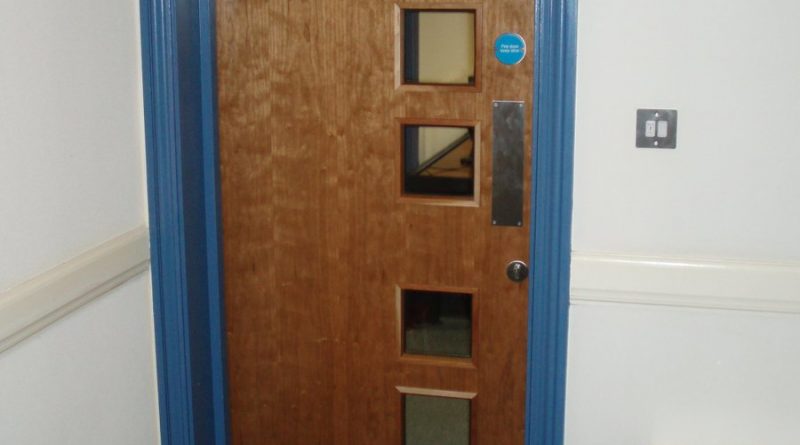Fire Door Compliance: A Case Of Life Or Death
Fire Door Compliance: A Case Of Life Or Death
To mark the start of Fire Door Safety Week 2019, Pat Jefferies, Commercial Director at Abloy UK, discusses how fire door specification can mean the difference between life and death.
When it comes to access control in public buildings, there is no greater responsibility than specifying the correct locking solution on emergency escape and fire doors.
There were 177,844 fires in England in 2018, which was a 5% increase compared with the previous year [1]. This number is far greater than it should be, and in order to prevent further casualties and fatalities, it’s imperative that fire doors and emergency escape doors are compliant and regularly checked.
Who is responsible?
As well as having a moral obligation to ensure access control systems adhere to the latest regulations, there is also a legal requirement for those in charge of a public building – whether that’s an employer, building owner, or facilities or building manager.
In 2005, the Regulatory Reform (Fire Safety) Order 2005 3 – commonly known as the Fire Safety Order or FSO was passed – this places responsibility for fire safety in buildings to whoever has day-to-day control of the premises [2].
However, even with such regulations in place there is little awareness of who is responsible for fire safety duties. There needs to be greater education on escape and fire door safety, and how to ensure the solutions specified are safe and compliant. This is not just to guarantee the safety of a building’s occupants, but also to make sure that the building manager is not liable if an accident does occur.
Setting the standard
There are a number of building regulation standards in place that relate to access control, and it’s essential that these are adhered to in order to ensure safety and security.
These include EN179 Emergency Escape (for when the building occupants are aware of the building environment), EN1125 Panic Escape (for environments used by the general public) and the new standard EN13637 Electronically Controlled Escape Systems (for use on escape routes).
These standards state that even if a door is electronically controlled for access there must be a compliant mechanical means of escape in an emergency.
In the case of fire doors this is essential to provide fire protection, compartmentalise a building and protect the escape routes. This is also a critical function in a terror situation – offering the ability to shut off certain areas to terrorists and allow controlled egress or access to ensure the safety of the public.
Compliant solutions
In the event of an emergency such as a fire, there needs to be a reliable exit route that allows a quick and easy escape, so it’s vital the correct locking solutions are installed at access points.
There are safety advantages to be gained by opting for an electric locking system – such as a motorised or solenoid lock – rather than choosing door magnets.
This is because there can be fire risks associated with installing a magnet on a door which is used as a fire escape, as they require special arrangements to guarantee they are fail-safe at all times in the event of an emergency.
For example, some door magnets require an alarm or ‘request to exit’ mechanism to allow someone to exit, so there could be life-threatening delays for people needing swift egress in an emergency situation.
Electric locks are also a more energy efficient solution when compared with magnetic locks – 13 door magnets use around the same amount of electricity as a kettle being constantly boiled all day. In comparison, electric locks will only require around 10-20 per cent of this amount of energy to operate for the same amount of time.
Abloy’s solution
Abloy UK offers a selection of compliant security solutions that are specifically designed for panic and escape doors. Its range of electric locks includes motor and solenoid locks, which are the most effective forms of electric locking and adhere to the mandatory fire and escape standards.
Solenoid locks, like the Abloy EL560 work by controlling the handle, and are suitable for internal doors of public buildings, offices, schools or hospitals, and external doors of apartments and detached houses.
Motorised locks, like the Abloy EL520 work by drawing the bolt back once a proximity card or device is presented. Both locks automatically secure a deadbolt upon closing and can be used with escape mechanisms as appropriate to the environment and application.
Safety vs security
Access control has often been described as the ‘ability to control the flow of honest people’, while security prevents ‘unauthorised entry’. Too often either solution fails to meet their design intention because of compromises between safety and security.
Following the publication of the Constructions Product Directive and the arrival of EN 13637 for Electrically Controlled Emergency Escape Doors, there is now a full set of escape standards.
With this in mind, Abloy runs a number of courses via its Academy, including the Foundations Course, Foundations Plus, and Digital Transformation in Physical Security.
It’s been very clearly highlighted in recent years how crucial it is that compliance is taken seriously and that specifiers of access control solutions for emergency escape and fire doors ensure that systems adhere to the latest regulations – it could save lives.
For further information on products and services available from Abloy UK or to book a place on one of the courses, https://bit.ly/2lyQyYU, call 01902 364 500, or email academy@abloy.co.uk.


